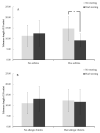Impact of Snoring on Telomere Shortening in Adolescents with Atopic Diseases
- PMID: 34069972
- PMCID: PMC8157836
- DOI: 10.3390/genes12050766
Impact of Snoring on Telomere Shortening in Adolescents with Atopic Diseases
Abstract
Atopic diseases can impose a significant burden on children and adolescents. Telomere length is a cellular marker of aging reflecting the impact of cumulative stress exposure on individual health. Since elevated oxidative stress and inflammation burden induced by chronic atopy and snoring may impact telomere length, this study aimed to investigate whether snoring would moderate the relationship between atopic diseases and telomere length in early adolescence. We surveyed 354 adolescents and their parents. Parents reported the adolescents' history of atopic diseases, recent snoring history as well as other family sociodemographic characteristics. Buccal swab samples were also collected from the adolescents for telomere length determination. Independent and combined effects of atopic diseases and snoring on telomere length were examined. Among the surveyed adolescents, 174 were reported by parents to have atopic diseases (20 had asthma, 145 had allergic rhinitis, 53 had eczema, and 25 had food allergy). Shorter TL was found in participants with a history of snoring and atopic diseases (β = -0.34, p = 0.002) particularly for asthma (β = -0.21, p = 0.007) and allergic rhinitis (β = -0.22, p = 0.023). Our findings suggest that snoring in atopic patients has important implications for accelerated telomere shortening. Proper management of atopic symptoms at an early age is important for the alleviation of long-term health consequences at the cellular level.
Keywords: adolescence; asthma; rhinitis; snoring; telomere length.
Conflict of interest statement
The authors declare no conflict of interest.
Figures



Similar articles
-
Associations between early life parent-child separation and shortened telomere length and psychopathological outcomes during adolescence.Psychoneuroendocrinology. 2019 May;103:195-202. doi: 10.1016/j.psyneuen.2019.01.021. Epub 2019 Jan 21. Psychoneuroendocrinology. 2019. PMID: 30711896
-
Snoring and atopic disease: a strong association.Pediatr Pulmonol. 2004 Sep;38(3):210-6. doi: 10.1002/ppul.20075. Pediatr Pulmonol. 2004. PMID: 15274099
-
Early life environmental exposure in relation to new onset and remission of allergic diseases in school children: Polish Mother and Child Cohort Study.Allergy Asthma Proc. 2019 Sep 1;40(5):329-337. doi: 10.2500/aap.2019.40.4237. Allergy Asthma Proc. 2019. PMID: 31514791
-
Genetic, Environmental and Lifestyle Determinants of Accelerated Telomere Attrition as Contributors to Risk and Severity of Multiple Sclerosis.Biomolecules. 2021 Oct 13;11(10):1510. doi: 10.3390/biom11101510. Biomolecules. 2021. PMID: 34680143 Free PMC article. Review.
-
Telomeres and early-life stress: an overview.Biol Psychiatry. 2013 Jan 1;73(1):15-23. doi: 10.1016/j.biopsych.2012.06.025. Epub 2012 Jul 24. Biol Psychiatry. 2013. PMID: 22831981 Free PMC article. Review.
Cited by
-
Characteristics of salivary telomere length shortening in preterm infants.PLoS One. 2023 Jan 17;18(1):e0280184. doi: 10.1371/journal.pone.0280184. eCollection 2023. PLoS One. 2023. PMID: 36649354 Free PMC article.
-
Genetic Variations in Nucleotide Excision Repair Pathway Genes and Risk of Allergic Rhinitis.Mediators Inflamm. 2022 Jun 3;2022:7815283. doi: 10.1155/2022/7815283. eCollection 2022. Mediators Inflamm. 2022. PMID: 35693108 Free PMC article.
-
Telomere Shortening and Its Association with Cell Dysfunction in Lung Diseases.Int J Mol Sci. 2021 Dec 31;23(1):425. doi: 10.3390/ijms23010425. Int J Mol Sci. 2021. PMID: 35008850 Free PMC article. Review.
References
-
- Sterner T., Uldahl A., Svensson Å., Björk J., Svedman C., Nielsen C., Tunsäter A., Bruze M., Kiotseridis H. The Southern Sweden Adolescent Allergy-Cohort: Prevalence of allergic diseases and cross-sectional associations with individual and social factors. J. Asthma Off. J. Assoc. Care Asthma. 2019;56:227–235. doi: 10.1080/02770903.2018.1452033. - DOI - PubMed
-
- Asher M.I., Montefort S., Björkstén B., Lai C.K., Strachan D.P., Weiland S.K., Williams H. Worldwide time trends in the prevalence of symptoms of asthma, allergic rhinoconjunctivitis, and eczema in childhood: ISAAC Phases One and Three repeat multicountry cross-sectional surveys. Lancet. 2006;368:733–743. doi: 10.1016/S0140-6736(06)69283-0. - DOI - PubMed
Publication types
MeSH terms
LinkOut - more resources
Full Text Sources
Medical

